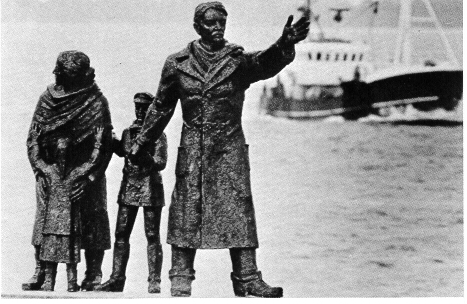



We present this essay, a translation from the German, as an example of one ethnic group's experience in the United States. At a time, when ethnic or nationalist conflicts have caused some countries to disintegrate, ethnicity has become associated with nationalist passions, fundamentalist ideology and religious fervor. Actually, the term "ethnicity" refers to group identification, to things held in common, such as language, cultural values, and history. It is about our lives as part of deeply-felt traditions, about cultural identity, belonging and understanding, based on these commonalities.
After a half century of dormancy, the interest in roots re-awakened; in the United States during the 1960s, ethnicity has become respectable. In the political arena this resulted in demands for, and acceptance of, civil rights, the eschewing of once popular ethnic jokes and slurs, and an affirmative approach to cultivating the status of minorities. In family circles it generated a vigorous pursuit of genealogy and heritage which today is fostered by ready access to records. These include microfilms of federal manuscript censuses, the Latter-day Saints' Library in Salt Lake City which opened its vast records to the public, and organizations and commercial services that have arisen in many countries to assist the researcher. And it has led to affirming the United States as a multicultural nation, not a melting pot, but a patchwork quilt, in which the various elements are a source of strength and pride.
Willi Paul Adams' study was first published in Berlin in 1990. It was occasioned by his experience of what has become a source of serious internal conflict in Germany. Accelerated by the Fall of the Wall and the end of communism, a continuous flow of refugees, asylum seekers and the destitute from former communist and less-developed countries, have been entering Germany, testing the newly-unified country's economic and emotional ability to deal with the foreigners in their midst. Like America, modern Germany has become a prime destination for immigrants. But unlike the United States whose population, despite repeated poicy efforts at rapid Americanization, has been developing along multi-ethnic/multi-cultural lines, Germany has a long history of being home to a largely homogeneous people. That makes it much harder to accept groups of various and markedly different backgrounds, languages, and cultures.
Nevertheless, the American experience of the last three hundred years offers some fascinating parallels. Millions of people headed for these shores, driven by crop failures and hunger, over-population and unemployment, religions, political and racial persecution, war and destruction. The German contingent happened to become the largest. This is confirmed by the 1990 Census, according to which more Americans claim German "ancestry or ethnic origin" than any other: 57.9 million (23.3%). In comparison, 38.7 million (15.6%) claim Irish ancestry, 32.7 million (13.1%) English, 23.8 million (9.6%) Afro-American, 14.7 million (5.9%) Italian, and smaller numbers for other groups. Earlier in this century, the identification with German ethnicity in the United States was dampened as a result of the anti-German hysteria during World War I and the crimes of the Hitler regime.
The motto of the United States, e pluribus unum (One out of many), reminds us that each generation is called upon to work toward ethnic and racial harmony and to overcome tensions and violence born out of indifference, misunderstanding and distrust. Professor Adams' essay wants to be such a reminder. It neither glorifies the importance of German roots, nor denies the fact that America has been very strongly shaped by its German element. Rather, this essay explores the meaning of German immigration and shows how completely Americans of German descent have been integrated into the American mainstream. It also shows that successful processes of assimilation or integration take time and a spirit of openness and mutual respect.

In translating the text, we occasionally adapted it, and the pictorial selections, for an American audience.
"A German-American Chronology" section has been added to assist with orientation in historical time. It also includes some of the key events in the history of Germany.
For reasons of accessibility, the bibliography in the original edition included only German-language sources. We followed the same considerations and limited ours to titles in English. But this also means that a few sources cited in the text do not appear in the bibliography.
Thanks are due to the individuals, organizations, institutions and publishers whose illustrations we incorporated, especially to Chelsea House Publishers whose volumes on The German Americans, The Jewish Americans, The Immigrant Experience, and Immigrants Who Returned Home -- all from the highly recommended series The Peoples of North America -- have been most helpful. We also thank the German Information Center in New York for encouraging and supporting this American Edition.


